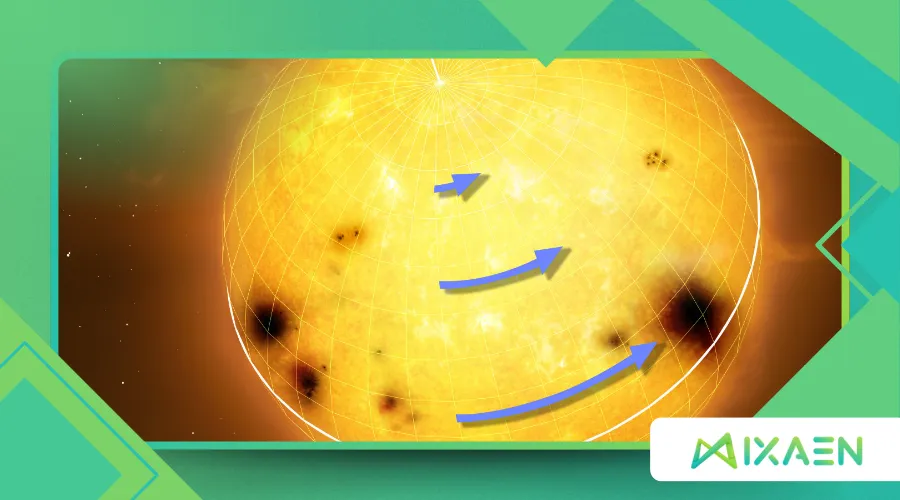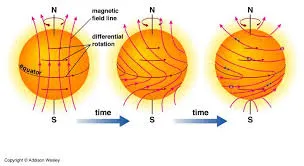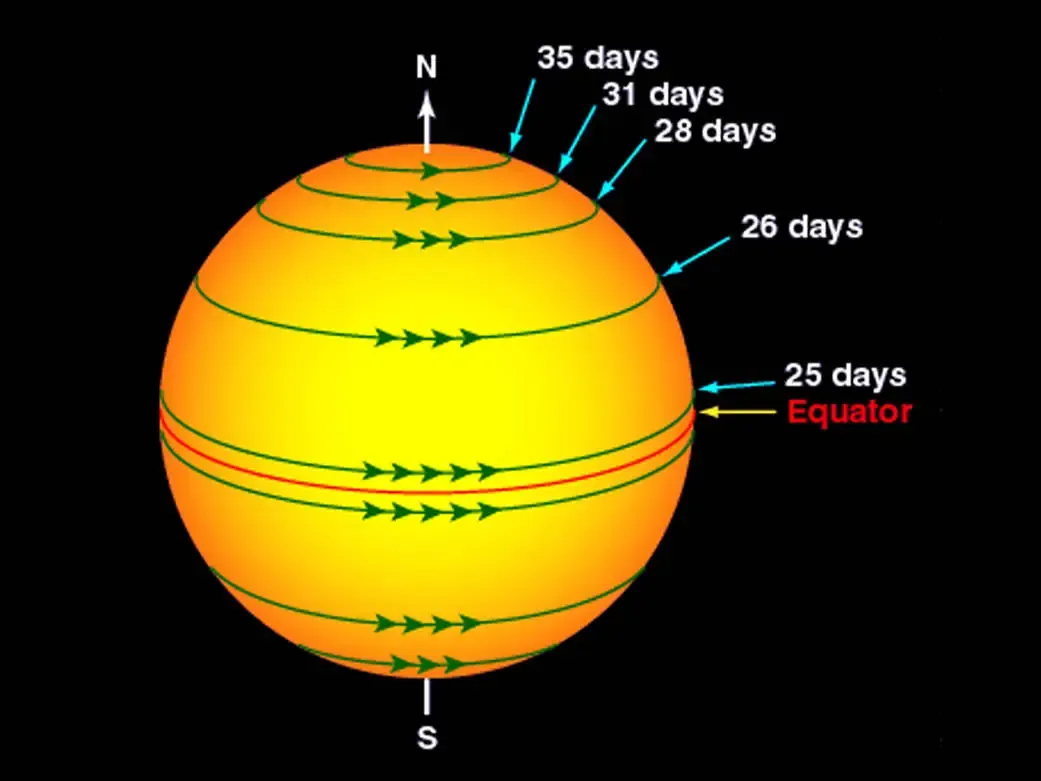What Causes the Sun’s Differential Rotation? Unraveling the Star’s Dynamic Spin

The sun’s differential rotation is a fascinating phenomenon, where our star’s surface spins at varying speeds depending on latitude.
Anúncios
Unlike a solid body, the Sun rotates faster at its equator—completing a rotation in about 25 days—while its polar regions take roughly 35 days.
This dynamic behavior shapes solar activity, drives magnetic field generation, and influences space weather.
But what causes this peculiar rotational pattern?
To answer, we must dive into the Sun’s complex internal mechanics, plasma dynamics, and the latest research shedding light on this stellar puzzle.
This article explores the forces behind the sun’s differential rotation, weaving together physics, observational evidence, and cutting-edge simulations to reveal why our star dances to such a unique rhythm.
Understanding the implications of this phenomenon is essential, as it affects not only solar dynamics but also the space weather that impacts Earth.
The Sun as a Plasma Powerhouse
Imagine the Sun as a colossal, swirling ocean of plasma—a fluid of charged particles governed not by rigid mechanics but by the interplay of heat, magnetism, and gravity.
This fluid nature is key to understanding the sun’s differential rotation.
Unlike Earth’s solid crust, the Sun’s outer layers consist of ionized gas, allowing different regions to move independently.
The equator’s faster spin results from the intricate balance of forces within this plasma, driven by convection, angular momentum, and temperature gradients.
Deep within the Sun, energy from nuclear fusion in the core travels outward through the radiative zone and into the convective zone, a turbulent layer where hot plasma rises, cools, and sinks.
This convection, akin to boiling water in a pot, creates patterns of motion that influence rotation.
The question arises: how does this turbulent flow translate into the sun’s differential rotation?
The answer lies in the interplay of convection with the Sun’s rotation and magnetic fields, a process scientists are still unraveling through advanced models.
Recent advancements in observational technology have allowed scientists to map these plasma flows with greater precision, revealing more about the Sun’s internal dynamics.
The Role of Convection and Angular Momentum
Convection in the Sun’s outer layers is a primary driver of its differential rotation.
As plasma rises and falls in the convective zone, it carries angular momentum, the rotational energy tied to the Sun’s spin.
At the equator, plasma moves faster because convective cells—large-scale flows called “supergranules”—align with the Sun’s rapid rotation.
Near the poles, these flows are slower, partly because the geometry of the spherical Sun constrains motion at higher latitudes.
A 2023 study published in The Astrophysical Journal used helioseismology—observing sound waves within the Sun—to map its internal flows.
The research revealed that the sun’s differential rotation extends into the convective zone, with a sharp transition at the tachocline, a boundary layer between the convective and radiative zones.
This suggests that angular momentum transport, influenced by convective turbulence, shapes the rotation profile.
For example, imagine a figure skater spinning faster by pulling in their arms; similarly, plasma near the equator conserves angular momentum, speeding up as it moves inward.
To illustrate, consider a hypothetical experiment: if we could “freeze” the Sun’s convection, the differential rotation would likely diminish, as the plasma’s fluid motion sustains the latitudinal variation.
This highlights convection’s pivotal role in maintaining the sun’s dynamic spin.
Understanding the precise mechanisms of angular momentum transport can lead to more accurate models of solar behavior and its effects on space weather.

Magnetic Fields and Their Feedback Loop
Magnetic fields add another layer of complexity to the sun’s differential rotation.
The Sun’s magnetic dynamo, responsible for sunspots and solar flares, is intimately tied to its rotational patterns.
As plasma flows shear and twist magnetic field lines, they amplify the field’s strength, which, in turn, influences plasma motion.
This feedback loop creates a delicate balance, where magnetic forces can either enhance or dampen differential rotation.
For instance, during the solar cycle’s peak, magnetic activity intensifies, potentially slowing rotation in certain regions.
Picture a dancer twirling with ribbons: as the ribbons (magnetic fields) tangle, they resist the dancer’s spin, altering their speed.
This analogy captures how magnetic fields interact with the sun’s differential rotation, creating localized variations in rotational speed.
Data from NASA’s Solar Dynamics Observatory (SDO) shows that sunspots, which mark intense magnetic activity, rotate slightly slower than surrounding plasma, suggesting magnetic drag.
This interplay raises a compelling question: could magnetic fields eventually reshape the sun’s differential rotation over millions of years?
While current models don’t predict drastic changes, ongoing research aims to clarify this relationship.
For more detailed insights into solar magnetic fields and their effects, you can refer to NASA’s Solar Dynamics Observatory.
The Tachocline: A Crucial Boundary
The tachocline, a thin layer between the convective and radiative zones, plays a critical role in the sun’s differential rotation.
Here, the rotation shifts from the fluid-like, latitudinally varied pattern of the convective zone to the nearly uniform rotation of the radiative interior.
This shear zone amplifies magnetic fields, fueling the solar dynamo.
But what causes the tachocline’s unique dynamics?
Simulations suggest that the tachocline’s steep velocity gradient results from the contrast between the convective zone’s turbulent flows and the radiative zone’s stable, rigid rotation.
A useful example is a river meeting a dam: the flowing water (convective zone) slows abruptly at the barrier (radiative zone), creating a turbulent boundary.
In the Sun, this boundary concentrates shear, sustaining the sun’s differential rotation.
Table 1: Key Features of the Sun’s Internal Layers
| Layer | Depth (approx.) | Role in Differential Rotation |
|---|---|---|
| Convective Zone | 0–200,000 km | Drives differential rotation via plasma flows |
| Tachocline | ~200,000 km | Shear zone amplifying magnetic fields |
| Radiative Zone | 200,000–500,000 km | Rotates uniformly, contrasting with outer layers |
Exploring the tachocline’s dynamics can provide deeper insights into the Sun’s magnetic activity and its broader implications for solar phenomena.

Meridional Flows and Global Circulation
Beyond convection, meridional flows—north-south circulations in the Sun’s outer layers—also influence the sun’s differential rotation.
These flows redistribute angular momentum, counteracting or reinforcing latitudinal variations.
For example, plasma moving poleward carries angular momentum, potentially slowing equatorial rotation while speeding up polar regions.
Recent observations from the European Space Agency’s Solar Orbiter mission, launched in 2020, have provided high-resolution data on these flows.
The mission’s findings suggest that meridional circulation varies with the 11-year solar cycle, impacting the sun’s differential rotation.
During solar minimum, weaker flows may allow stronger differential rotation, while stronger flows during solar maximum could temper it.
To visualize, think of a conveyor belt in a factory: as materials (plasma) move along, they adjust the belt’s speed at different points.
Similarly, meridional flows fine-tune the Sun’s rotational profile, adding nuance to its dynamic behavior.
Continued observations will help clarify how these flows interact with the Sun’s overall rotation and magnetic activity.
+ The Sun’s Role in Triggering Earth’s Geomagnetic Storms
External Influences: A Cosmic Perspective
Could external forces, like gravitational interactions with planets, affect the sun’s differential rotation?
While the Sun dominates the solar system’s mass, tidal effects from Jupiter and other planets are negligible, contributing less than 0.01% to rotational variations, according to helioseismic data.
Instead, internal dynamics overwhelmingly drive the phenomenon.
However, studying other stars offers a broader perspective.
Observations of Sun-like stars via the Kepler Space Telescope reveal that differential rotation is common but varies with stellar mass and age.
Younger, faster-rotating stars often exhibit stronger differential rotation, suggesting that the Sun’s rotation may have been more pronounced billions of years ago.
This comparative approach underscores the universality of the sun’s differential rotation while highlighting its unique characteristics.
Table 2: Differential Rotation Across Stellar Types
| Star Type | Rotation Period (Equator) | Differential Rotation Strength |
|---|---|---|
| Sun (G-type) | ~25 days | Moderate (~10–14% variation) |
| Younger G-type | ~10–15 days | Strong (~20–30% variation) |
| F-type (hotter) | ~5–10 days | Weak (~5–10% variation) |
This comparative analysis not only enhances our understanding of the Sun but also contributes to our knowledge of stellar evolution across the galaxy.
Why It Matters: Space Weather and Beyond
The sun’s differential rotation isn’t just a curiosity—it drives solar activity with real-world impacts.
By shearing magnetic fields, it generates sunspots, flares, and coronal mass ejections, which can disrupt Earth’s communication systems and power grids.
A 2019 study estimated that a severe solar storm, fueled by differential rotation’s magnetic effects, could cause $2 trillion in global economic damage.
Understanding this phenomenon is crucial for predicting space weather and protecting technology.
Moreover, studying the sun’s differential rotation informs models of stellar evolution.
By decoding the Sun’s behavior, scientists refine predictions about other stars, enhancing our understanding of galactic dynamics.
For instance, simulating a star without differential rotation could reveal how its absence alters magnetic activity, offering insights into exoplanet habitability.
This knowledge is vital for developing strategies to mitigate the effects of space weather on modern technology and infrastructure.
++ The Sun as a Laboratory for Studying Plasma Physics
Challenges and Future Directions
Despite progress, mysteries persist.
Why does the sun’s differential rotation remain stable over centuries?
Current models struggle to fully reconcile observed rotation rates with theoretical predictions, particularly at the poles.
Next-generation simulations, leveraging AI and high-performance computing, aim to bridge this gap by modeling plasma turbulence at unprecedented scales.
Future missions, like NASA’s planned Solar-C (expected launch in 2028), will provide deeper insights into the sun’s differential rotation by combining helioseismology with high-resolution imaging.
These efforts promise to refine our understanding of the Sun’s internal dynamics and their broader implications.
As technology advances, we can expect more comprehensive models that will illuminate the complexities of solar behavior and its impact on the solar system.
A Star in Motion
The sun’s differential rotation is a testament to the complexity of stellar physics, driven by convection, magnetic fields, and the tachocline’s shear.
It’s a cosmic dance, where plasma, momentum, and magnetism intertwine to create a star that spins not as a rigid sphere but as a fluid mosaic.
By exploring this phenomenon, we not only decode the Sun’s behavior but also glimpse the universal principles governing stars across the cosmos.
So, the next time you feel the Sun’s warmth, ask yourself: what secrets does its restless spin hold for the future of our planet and beyond?
This inquiry not only enhances our understanding of our star but also enriches our perspective on the broader universe.
